Our Grape Varieties
Situated around an ancient local stone farmhouse and a collection of very old wells with galleries, remnants of the Gallo-Roman period, the estate spans nearly 14 hectares in one single plot, with 12 hectares currently under cultivation.
Approximately 6 hectares are planted with old vines:
Vermentino (Vermentinu or Rolle) for the white wines, Cinsault, Syrah, Grenache Noir, and Cabernet Sauvignon for the red wines with aging potential, planted during the years 1969, 1970, and 1980.
For the remaining area, we planted classic grape varieties of the region in 2019:
Grenache Blanc, Vermentino, Sémillon, Cinsault, Grenache Gris, and Carignan.
Additionally, we planted some less common varieties for this area:
Sémillon, Colombard, Airen, Biancu Gentile (or Bianco Gentille), Muscat of Alexandria, Tibouren, Sciaccarello (or Sciaccarellu), Macallu (or Mourvèdre), Cabernet Franc, Petit Verdot, Carmenere, and Nielluccio (Nielluciu, Brunello or Sangiovese).
This represents approximately 9 hectares of AOP (Appellation d’Origine Contrôlée) “Côtes de Provence,” including 2 hectares for which we have obtained the special status of DGC (Dénomination Géographique Complémentaire) “Côtes de Provence – Notre Dames des Anges.” The Notre Dame Chapel, symbolizing this appellation, is the highest point of the Maures Massif (767 m).
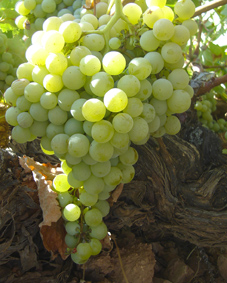
Airen
(Variants: Aiden, Lairen or Layren, Blancon, Manchega, Forcallat or Forcayat)
- Identification / Origin:
Airen is an ancient grape variety from the Mediterranean region, widely found in Spain and also present in Portugal.
- Description:
The Airen grapevine produces very large and moderately compact clusters, with strong medium-sized peduncles often displaying a lignified part. The berries are medium-sized, with thin skin and a white color that turns pinkish upon full maturity. The pulp is very juicy, and the foliage is highly intertwined.
Biancu Gentile
(Variants: Bianco Gentille, Biancone, Jentile, Ghjintili)
- Identification / Origin:
Biancu Gentile is an indigenous grape variety from the Sartène region of Corsica.
- Description:
The grapevine yields large, cylindro-conical and winged clusters, with medium-sized, rounded berries in a greenish-white to light yellow or amber color, depending on sun exposure and full maturity. Biancu Gentile foliage is characterized by a very distinct dark green color.
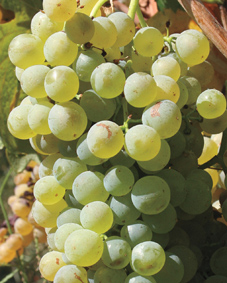
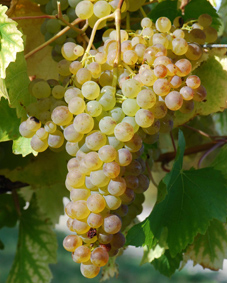
Colombard
(Variants: Colombier, Chabrier Vert, Bon Blanc, Queue Tendre, Gros Blanc Roux)
- Identification / Origin:
Colombard is one of the oldest grape varieties from the Charente region of France. Genetic analysis suggests it is a natural cross between Gouais and Chenin grapes.
- Description:
The grapevine produces medium-sized, cylindro-conical, winged and compact clusters with small, ovoid, greenish-white to golden yellow berries at full maturity. The pulp is juicy.
Vermentino
(Variants: Vermentinu, Rolle, Malvasia in Corsica, Picabon, Pigato, Favorita, Furmentin, Garbesso)
- Identification / Origin:
Vermentino originated from Anatolia (Turkey) and is related to the Rossola Bianca grape variety. It was introduced to Italy by Genoese traders and can also be found in Bulgaria, Hungary, Switzerland, Germany, Spain, Portugal, the United States, Canada, Argentina, and Australia.
- Description:
The grapevine bears medium-sized clusters, typically with a well-developed wing, and medium-sized berries with thick, firm, amber-white skin, which sometimes turns pinkish at over-maturity. The flesh is firm.
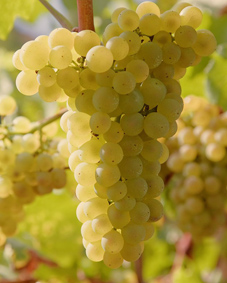
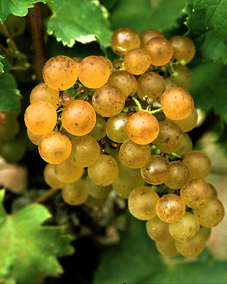
Sémillon
(Variants: Chevrier, Blanc Doux, Mansois, Mancès, Sauternes, Dausne, Semijon, Merwah in Lebanon)
- Identification / Origin:
Sémillon originates from the Gironde region, specifically Sauternes in France. It can also be found in Bulgaria, Croatia, Hungary, the Czech Republic, Cyprus, Greece, Italy, Spain, and Portugal.
- Description:
The grapevine produces medium-sized, cylindrical clusters with medium-sized berries that have thick, golden-white skin and an abundant, slightly muscat-flavored juice.
Muscat d’Alexandrie
(Variants: Panse musquée, Augibi, Gibi Muscat, Hanepoot, Zibibbo, Raisin de Malaga, Raisin de Calabre, Gerosolimitana Rossa, Salamanca Bianca, Moscatel)
- Identification / Origin:
Vitis vinifera originating from a natural cross between Muscat à Petits Grains Blancs and Heptakilo.
- Description:
The grapevine yields large, cylindro-conical clusters with somewhat long and strong peduncles. The berries are large, with a fairly thin and resistant skin that transitions from a matte green to greenish-yellow or golden yellow depending on maturity and sun exposure. The flesh is firm, crunchy, juicy, sweet, and highly muscat-flavored.
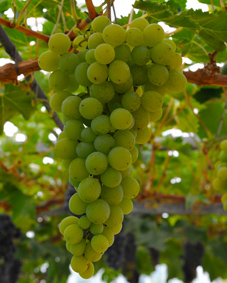

Grenache Blanc, Grenache Gris or Noir
(Variants: Garnacha, Garnatxa, Tinto, Bois Jaun, Tocai Rosso, Cannonau, Redondal, Elegante, Aragonés, Francese, Redondal)
- Identification / Origin:
Likely of Spanish origin.
- Description:
The grapevine produces medium to large conical, winged, and compact clusters with lignified peduncles at maturity. The berries are medium-sized, with a very waxy, fairly thick, beautiful blue-black skin – also available in white, gray, and pink. The pulp is melting, and the juice is colorless and abundant.
Tibouren
(Variants: Tiboulen, Tantiboulen, Antibouren, Antibois, Tibur, Sarreiron in the Cuers region (Var), Gaysserin, Geysserin, Peillous or Peilloux, Rossese in Italy)
- Identification / Origin:
An ancient grape variety from southern France, likely introduced by the Romans from Asia Minor. It is almost exclusively found in the Var department in France, with some presence in Bulgaria and northern Italy.
- Description:
The grapevine bears medium to large clusters, with medium-sized, spherical or slightly ovoid berries. The skin is slightly waxy and blue-black in color (a white variant exists but is very rare). The flesh is firm, juicy, sweet, and pleasantly spicy.


Carigan
(Variants: Carignane, Bois Dur, Crinana, Catalan, Cariñenu, Carinyena, Mazuela, Mazuelo, Samso or Catalan in Catalonia, Bobal or Béni Carlo in Spain)
- Identification / Origin:
A grape variety originating from Spain, specifically the Aragon region.
- Description:
The grapevine yields fairly large, cylindro-conical, compact, winged clusters with a lignified peduncle. The berries are medium-sized, spherical, with a thick, astringent, blue-black skin, also available in white and gray. The juice is colorless and sweet.
Sciaccarello
(Variants: Sciaccarellu, Muntanaccio, Broumest, Mammolo Nero in Italy)
- Identification / Origin:
A grape variety originating from Tuscany, Italy. Genetic analysis indicates it is identical to the Mammolo Nero grape variety cultivated in Italy.
- Description:
The grapevine produces medium to large, truncated, compact, sometimes winged clusters with short and strong peduncles. The berries are medium-sized, ellipsoidal, with a thick, crunchy, violet-black to red-black skin at full maturity. The flesh is juicy.

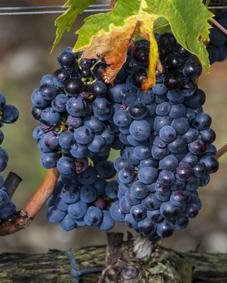
Nielluccio
(Variants: Nielluciu, Brunello, Sangiovése Niella, Negretta, Angioveto, Sangiogheto, Sangiveto, San Gioveto Grosso, Prugnolo Gentile di Montepulciano, Brunello, Morellino, Uva Abruzzi, Uva Tosca, Tuccanese, Calabrese)
- Identification / Origin:
Native to Italy, this grape variety is the famous Sangiovese from Tuscany, used to produce the renowned Brunello di Montalcino and Chianti wines. It is a result of a natural cross between the virtually unknown Calabrese di Montenuovo (mother) and Ciliegiolo (father) grape varieties.
Mourvèdre
(Variants: Macallu, Macalu, Estrangle Chien, Espar, Ataro, Damas Noir, Balzac, Rossola Nera in Corsica, Morastell or Monastrell in Catalonia, Matterou)
- Identification / Origin:
A grape variety of Spanish origin, long cultivated in Provence and known as the “King of Bandol.”
- Description:
The grapevine produces medium to large, conical, sometimes winged clusters, with medium-sized, spherical berries. The skin is thick and beautiful blue-black – white and gray variants exist but are very rare – and is heavily covered in bloom. The pulp is melting with a bitter flavor.
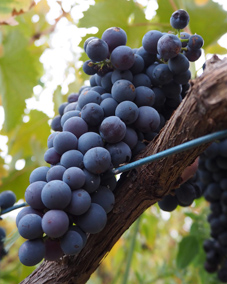

Carmenère
(Variants: Carmeneyre, Carmenelle, Cabernelle, Bouton Blanc, Grande Vidure in Médoc, Carbouet in Graves, Carbonet, Cabernet Gernischt in China)
- Identification / Origin:
An ancient grape variety native to the Bordeaux region, it is a result of a cross between Gros Cabernet and Cabernet Franc. It can be found in Bulgaria, Malta, Italy, and represents nearly 10% of the black grape varieties cultivated in Chile.
- Description:
The grapevine yields small to medium-sized clusters, with spherical berries covered in a blue-black skin abundant in non-persistent bloom. The pulp is soft with an herbaceous taste.
Petit Verdot
(Variants: Verdau, Héran or Herrant, Lambrusquet, Acheri Moyeta, Carmelin, Petit Mourastel)
- Identification / Origin:
Very likely native to the Bordeaux region, genetic analyses have confirmed that its father is the Tressot Noir grape variety. It can be found in Bulgaria, Spain, Portugal, Malta, and Italy.
- Description:
The grapevine yields small to medium-sized, cylindrical, fairly compact, sometimes winged clusters with medium-sized peduncles, partially lignified. The berries are small, spherical, with a beautiful, fairly resistant blue-black skin.
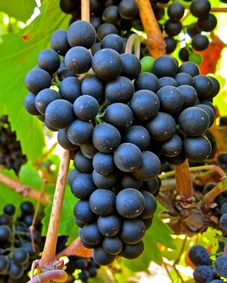
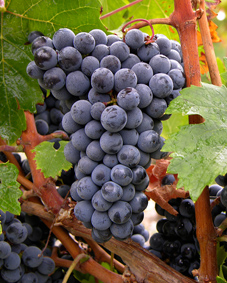
Cabernet Franc
(Variants: Bouchet in Gironde, Breton, Gros Bouchet, Bouchy in Madiran, Acheria, Noir Dur, Véronais, Crouchen noir, Carmenet, Grosse Vidure, Noir de Fontarrabie)
- Identification / Origin:
One of the oldest grape varieties cultivated in the Gironde region (1st century AD), it closely resembles two other now-extinct grape varieties, Morenoa and Hondarrabi Beltza, and surprisingly, it is related to the Jacquez variety.
- Description:
The grapevine produces medium-sized, sometimes winged clusters, with small to medium-sized, spherical berries. The skin is thin, beautiful blue-black, and covered in abundant bloom. The juice is sweet and slightly astringent.
Cabernet Sauvignon
(Variants: Petit Bouchet in St Emilion and Pomerol, Lafite, Petite Vidure, Vidure or Menut)
- Identification / Origin:
Believed to originate from the Gironde region in France, Cabernet Sauvignon is a result of the natural cross between Cabernet Franc and Sauvignon Blanc.
- Description:
The grapevine yields small to medium-sized, cylindrical, fairly compact, sometimes winged clusters with medium-sized peduncles, partially lignified. The berries are small, spherical, with a beautiful, fairly resistant blue-black skin.
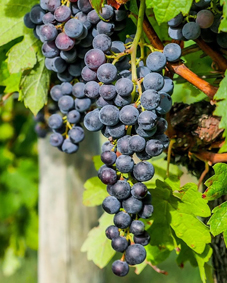

Cinsault
(Variants: Cinq Saou, Plan d’Arles, Boudalès, Bourdalès, Bourdelas, Morterille, Passerille, Picardan, Espagnen, Calabre, Hermitage in South Africa, Black Malvoisie in the USA, Blue Imperial in Australia, Ottavianello in Italy, Senzo in Bulgaria, Mavro Kara Melki in Russia)
- Identification / Origin:
Cinsault is a Vitis Vinifera grape variety, likely originating from the Provence region in France. It is the father of the famous “Pinotage” variety, well-known in South Africa.
- Description:
The grapevine produces large, cylindrical-conical clusters that are more or less compact, with medium peduncles that are slightly lignified. The berries are large, ellipsoidal, and have a firm, beautiful violet-black skin. White and grey variants exist. The pulp is very juicy and sweet.
Syrah
(Alternative names: Hermitage, Serin in Côte Rôtie, Sirane, Candive, Biaune, Sérène, Shiraz, Damas Noir, Serine, Siranin)
- Identification / Origin:
Syrah is native to the Rhône region in France and is a result of a natural cross between Mondeuse Blanche and Dureza, making it a relative of the Teroldego grape variety.
- Description:
The grapevine produces medium-sized, elongated clusters that are more or less compact, with long, sometimes bent peduncles. The berries are medium-sized, ovoid, with a thin blue-black skin. The pulp is firm, juicy, and sweet.


